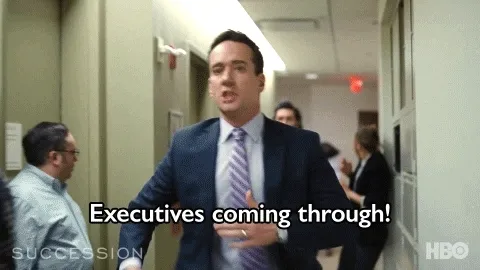How CHROs can prepare for an executive’s exit
Many companies have succession plans in place before they need them, Janice Burns, chief transformation officer at elearning platform Degreed, tells HR Brew.

Succession/HBO via Giphy
• 3 min read
Mikaela Cohen is a reporter for HR Brew covering workplace strategy.
In an ideal world, a CHRO could anticipate every resignation, especially those in the C-suite. But since we don’t live in an ideal world, the best a CHRO can do is proactively prepare.
Earlier this week, HSBC’s group CEO, Noel Quinn, announced his departure from the global bank after five years to “get a better balance between [his] personal and business life,” CNBC reported. While the news came as a surprise, and HSBC noted Quinn’s intent to stay on until a successor had been identified, the company isn’t likely starting its search from scratch, according to Janice Burns, chief transformation officer at elearning platform Degreed. Most companies, she said, have succession plans in place before they’ll need them.
Burns shared with HR Brew what CHROs should know when handling succession planning.
Under the hood. By the time a C-level exec leaves, their CHRO has likely identified successors, Burns told HR Brew.
“You have to have successors named for each of those critical positions from both a development perspective, so you know who you’re developing, but also from a crisis perspective, in case something happens to one of the officers unexpectedly,” she said.
Those successors may not be ready to take over immediately, though, so most companies plan for a one or two year transition, she added.
Given that, some companies also identify interim successors, Burns said, who can be critical for continuity. Other companies only identify interim successors, so they can open the search to external candidates.
Quick-to-read HR news & insights
From recruiting and retention to company culture and the latest in HR tech, HR Brew delivers up-to-date industry news and tips to help HR pros stay nimble in today’s fast-changing business environment.
Skills-based lens. A newer approach some companies are taking to succession planning, Burns said, is identifying successors based on skills, rather than previous roles. This strategy can be used for both internal and external candidates.
“You’re looking at employees from a skill-portfolio perspective,” she said.
A CHRO might consider, for example, who among their employees, or former employees, have knowledge and skills that, in one or two years, could make them a candidate for an executive role. When looking at external candidates, she said LinkedIn can be helpful, since profiles often include skills.
Power of a CHRO. Like a conductor of an orchestra, Burns said, a CHRO may arrange a succession plan, but it’s ultimately up to the C-suite and board of directors to help execute it. A conductor can’t play their musicians’ instruments for them, and a CHRO can’t bring a new leader into an organization on their own.
Burns said CHROs can use leadership shake ups as an opportunity to advocate for positive change within the C-suite.
“As the chief HR officer, you’re going to assess, does this org structure make sense for the long run?...Or are there other configurations of the org structure we should think about that may have diversity in HR, may have diversity someplace else, may elevate diversity to the CEO?” she said. “All of those things, you’re going to think about whenever you’re changing someone in leadership.”
Quick-to-read HR news & insights
From recruiting and retention to company culture and the latest in HR tech, HR Brew delivers up-to-date industry news and tips to help HR pros stay nimble in today’s fast-changing business environment.